Last updated: November 2, 2023
Article
Bison Effects: Research and Monitoring
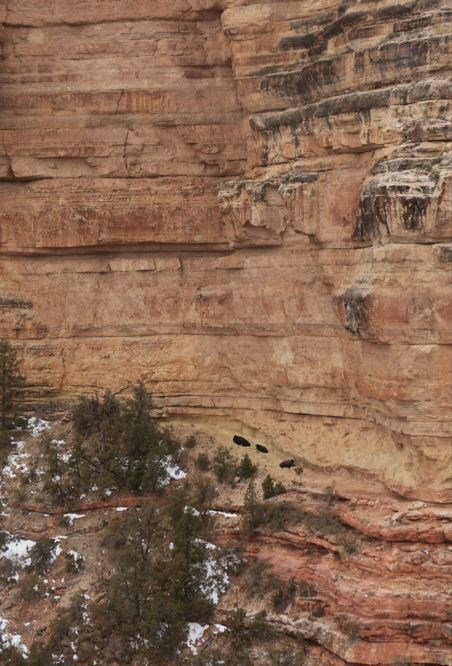
USGS Photo/ K. Schoenecker
Bison Safety
- Bison are wild animals and are unpredictable.
- Maintain a distance of 100 feet (30 m or two bus lengths) from bison.
- When the bison are within 100 feet (30 m) of the road, it is recommended to view them from inside a vehicle.
- Please use established gravel or paved pull-outs to park vehicles completely off the roadway (all wheels right of the white line). Do not walk or park in the road.
Why monitor bison effects?
In Grand Canyon National Park, bison are only found on the North Rim on the Kaibab Plateau. The Kaibab Plateau bison herd lives in a high elevation desert environment. They graze and wallow in park meadows, stampede through dense forests, winter along the rim of the canyon, and venture below the Kaibab limestone layer within the Grand Canyon. Historically bison in this area, at the edge or just outside of their range, would have occurred in small intermittent numbers at low density. Now however they are limited by human geography and tolerance. We know quite a bit about how bison interact in ecosystems such as the tall and short grass prairie where they are often in denser numbers but little about them in habitat similar to the Kaibab Plateau. There are concerns about the density of bison and effects they might have on this different ecosystem.
Effects of bison occur on both large and small spatial scales including: increased vegetation heterogeneity, nutrient redistribution, changes in plant species composition, creation and maintenance of grasslands, increased productivity in grasslands, competition with other herbivores, modification of fire regimes, modification of hydrological processes, and disturbance of woody vegetation. All of these effects can change wildlife habitat in ways that support some species and limit others, producing cascading effects on biodiversity and species composition. It is important to note that bison are a native grazer and the effects are likely different from that of cattle. Park staff and collaborators have undertaken research to learn more about local effects and to monitor them over time so that the herd can be managed at a size that is sustainable.
What do the studies show?
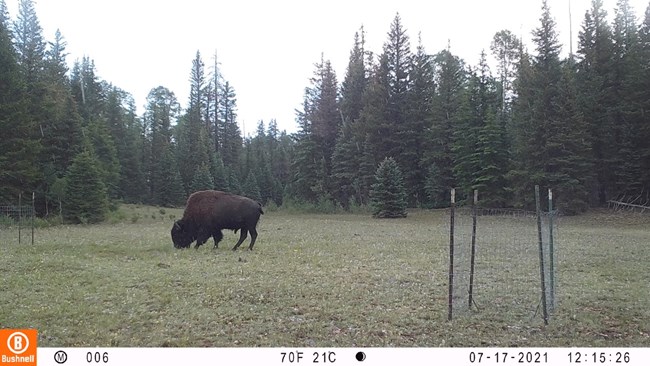
USGS Photo/ D. Musto
There is a long history of disturbance and grazing on the Kaibab Plateau going back at least as far as the 1500's with large numbers of livestock being grazed. At the begining of the 20th century it experienced intense wildlife grazing from deer in what is now a famous wildlife study called "the lesson of the Kaibab". As such it can be difficult to detemine the legacy effects of intensive grazing and current day effects by bison.
Herbaceous productivity in grazed ecosystems is one way to measure stability, resiliency, and sustainability of the ecosystem and its capacity to support herbivore populations. Large herbivores, such as bison can increase plant-available nutrients from nitrogen-rich waste deposition, accelerating a plants physiological mechanisms to reallocate nutrients and facilitate rapid regrowth. Landscape habitat heterogeneity can also be enhanced by bison grazing, particularly when grazing patterns are both spatially and temporally dynamic. The profound effects of bison herbivory on ecosystems can range from denuding to enhancing and varies among different grassland ecotypes and plant communities. Thus, determining the conditions under which grassland plants can recover or even thrive in the face of herbivory provides insight for managers seeking to balance grazers with grassland function.
There is an observable difference in vegetation height, cover, and litter accumulation between areas grazed by bison and those not (Reimondo 2012). However, research at water sources indicate that there is no difference in plant species richness between grazed and ungrazed areas nor is there a difference in soil compaction (Reimondo 2012) although there is greater forb cover in grazed areas than graminoids (Terwilliger et al. 2020).
Recent research done in collaboration with the U.S. Geological Survey and Colorado State University to study the effects of bison herbivory using large exclosures has just wrapped up (Musto 2023) . Results indicated that bison herbivory significantly influenced grassland properties in various ways; however, no negative impacts could be detected. Herbivory-induced alterations of grassland structure were observed by the higher coverage of forbs and lower graminoid cover in high bison density sites compared to the higher coverage of graminoids and litter in low density sites. Significantly enhanced herbaceous production and highest percent nitrogen (%N) in plants was recorded in high bison density areas; the maximum production and %N were recorded at sites where the highest level of bison grazing occurred. This continuous, positive linear relationship between offtake and production was only observed within areas grazed by bison. Our results suggest that the current level and pattern of grazing occurring in the Park is not degrading sustainability of this grazing ecosystem; results indicate that bison grazing stimulated herbaceous production by 24.9% and nitrogen yield by 37.6%.
For more details see:
- Ecological Impacts and Management Implications of Introduced Bison in the Grand Canyon Region. 2012. Reimondo. Thesis. Northern Arizona University.
- Management of the Kaibab Plateau bison herd in Grand Canyon National Park: 2018–2019 operations report. 2020. Terwilliger, Hartway, Schoenecker, Holm, Zeigenfuss, Swan, Salganek, Buttke, and Musto. Natural Resource Report NPS/GRCA/NRR—2020/2167. National Park Service, Fort Collins, Colorado.
- Ecology of Bison Herbivory in North Rim Grand Canyon Grasslands. 2023. Musto. Thesis. Colorado State University.
The park is currently researching the effects of bison on pollinator communities by ultilizing large (1 acre) grazing exclosures in areas with high bison grazing and areas with little to no bison grazing.
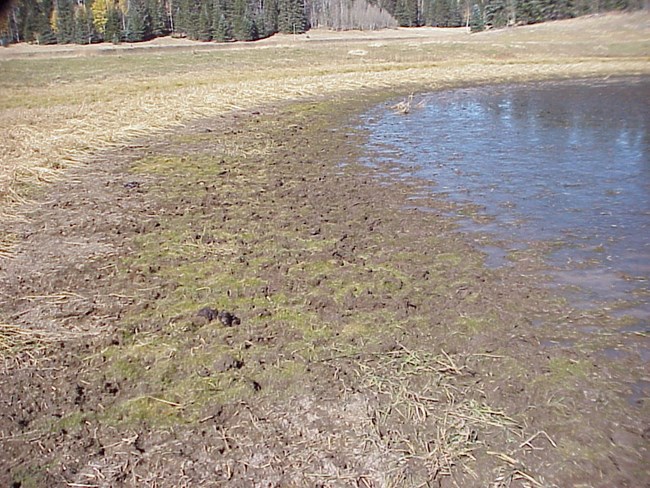
NPS Photo
The Kaibab plateau is characterized by a complete absence of live streams but instead has natural sinkhole springs and ponds and manmade dirt "tanks" that drain through the ground water system or is lost through evapotranspiration (Huntoon 1974). Water levels of these ponds fluctuate seasonally and between years and not always consistently with each other. They provide the most limiting resource of all in Grand Canyon: water. These sources do not contain any fish species but occasionally have tiger salamanders or other amphibians and have varying degrees of wetland vegetation. Currently little is know about insects and other aquatic invertebrate life in these springs.
The drinking water for Grand Canyon National Park comes from the aquifers fed by these water sources some 3,000ft below the North Rim.
Effects on Wetland Vegetation
There is an observable difference in vegetation height, cover, and litter accumulation between wetland areas utlized by bison and those not. Research shows that there is a relationship between bison use and reduced vegetation cover, reduced vegetative height, and increased exposure to bare spoil (Reimondo 2012). At the same time, research found no difference in plant species richness between grazed and ungrazed areas nor is there a difference in soil compaction at water sources (Reimondo 2012). Interestingly, bison wallows have created new water sources on the landscape.
For more details see:
- Ecological Impacts and Management Implications of Introduced Bison in the Grand Canyon Region. 2012. Reimondo. Thesis. Northern Arizona University.
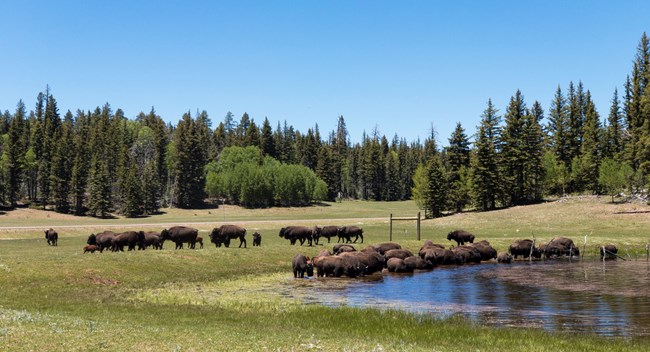
NPS Photo/ E. Keltz
Effects on Water Sources:
In 2017 the park fenced off water sources from bison. With water being a limiting resource for bison this proved ineffective and by the end of the season bison had destroyed most of the fencing.
Currently, the park and neighboring Kaibab National Forest are launching an environmental DNA (eDNA) study to look at water sources on the Kaibab Plateau. eDNA is organismal DNA that can be found in the environment and is shed by organisms (via skin, excrement, etc) into a water body and that can be sampled. This sampling can then be used to estimate number of species, types of speices, and can help with early detection of invasive species and the detection or rare or cryptic species. We will be looking at the species differences in water sources used by a) only bison, b) only cattle, c) not used by either (there are not water bodies currently used by both). This will help the agencies have a quantitative measurement of the influence bison and cattle are having, or not, on these water sources.
The park also has concerns that bison use has lead to an increase in E. coli contamination in park drinking water as it discharges into the aquifer from surface water sources. More research is needed to determine if this is the case.
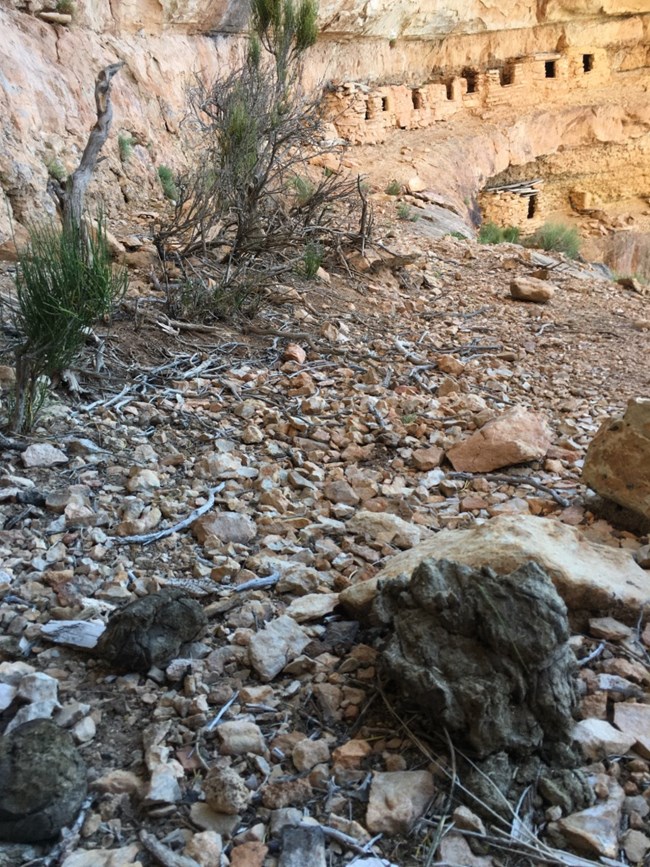
NPS Photo/ S. Salganek
Threats to Archeological Sites:
Park archeologists have found significant threats to culturally rich areas of the North Rim from the ongoing impacts of the Kaibab Plateau bison herd. Bison trample through archeological sites causing damage to artifacts and cultural features found on the surface and buried underground. This is apparent in the wallows and bison trails surrounding and within survey sites. Additionally there are concerns about sensitive sites such as prehistoric granaries below the rim being damaged by bison in the winter.
